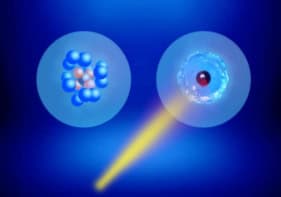Hamish Johnston reviews Superfluid: How a Quantum Fluid Revolutionized Modern Science by John Weisend

The effects of quantum mechanics are all around us, but the quantum properties of matter are generally only apparent at the microscopic level. Superfluid helium is an exception, and some of its bizarre characteristics can be seen with the naked eye. As John Weisend – an engineer at the European Spallation Source and Lund University – explains in his book Superfluid, these properties have made this curious substance an essential component of many cutting-edge technologies. Far from being a scientific curiosity, superfluid helium is used by researchers and engineers in multi-tonne quantities today.
In his book, which I enjoyed reading, Weisend explores how superfluid helium has played an important role in some of the most important scientific breakthroughs of the past 100 years. These include the discoveries of the Higgs boson at CERN and the inhomogeneities in the cosmic microwave background radiation – both of which led to physics Nobel prizes.
While Superfluid is aimed at the non-physicist, I found that there was lots to interest me as someone with a background in condensed-matter physics. Indeed, Weisend goes well beyond the physics, and provides a clear and concise description of how superfluid helium is used by engineers in scientific experiments. The book is illustrated using original technical drawings, which gives it a warm and historical feel.
Liquid helium and the birth of cryogenics
The strange properties of superfluid helium-4 (also known as liquid helium II) arise because of the quantum rules governing the symmetry of the wave functions of helium atoms. Electrons, which are fermions, cannot occupy the same quantum state, but the same is not true for helium-4 atoms. When chilled to below about 2 K, large numbers of the atoms can occupy the lowest energy (ground) state.
When this happens, the atoms form a superfluid. Superfluids can flow uphill and through very small openings, they conduct heat very efficiently, and will not boil like conventional liquids. Weisend explains that these properties make helium II extremely useful for cooling things to very low temperatures.
The book is illustrated using original technical drawings, which gives it a warm and historical feel
Superfluid begins in the late 19th century with the race to liquify gases such as oxygen, nitrogen and hydrogen – a race that created the modern field of cryogenics. Helium proved to be a challenge because its boiling temperature of 4.2 K is much lower than other gases. Furthermore, helium was only isolated on Earth in 1895 and was in short supply until 1903, when it was found in natural gas.
But a breakthrough came in 1908 when the Dutch physicist Heike Kamerlingh Onnes became the first to liquefy helium. Onnes then used his findings to chill various materials and measure their properties, which led to his discovery of superconductivity in 1911. He bagged the 1913 Nobel Prize for Physics for his work in cryogenics.

Thomas Kuhn: new insights into a revolutionary philosopher of science
Hints of superfluidity may have been spotted by Onnes when he saw evidence of a phase transition in liquid helium as the substance cooled. But despite this initial experimental success, it remained difficult to liquify helium until well into the 1930s, when the superfluid property of zero viscosity was first measured. This was done by both the Soviet physicist Piotr Kapitza and independently by the Canadian researchers Jack Allen and Don Misener. In a move that has not been forgiven by some Canadian physicists, including this reviewer, only Kapitza was awarded the 1978 Nobel Prize for Physics for the discovery.
One of the most fascinating aspects of helium II is that many of its unique and useful properties can be understood using a relatively simple model that describes it as having superfluid and normal-fluid components. This two-fluid model was developed in the late 1930s by German-born Fritz London and Hungarian Laszlo Tisza, and it is remarkably good at explaining how heat and mass are transferred by helium II – and Weisend also does a great job of describing the two-fluid model in his book.
The full-blown quantum-mechanical description of helium II was developed by Soviet theoretical physicist Lev Landau in 1941, for which he bagged a Nobel prize in 1962. Weisend describes the theory as difficult to understand and wisely does not attempt an in-depth explanation in his book.
Keeping cool
While physicists had a good understanding of helium II by the 1940s, it wasn’t until the 1960s when the unique properties of the substance began to be exploited by scientists and engineers – and Weisend devotes much of Superfluid to these applications. He explains that the two most useful features of helium II are its very low temperature and its very high heat conduction, the latter being due to a unique phenomenon called “internal convection”.
When helium II is in a temperature gradient, the normal component of the fluid moves away from the hot region, whereas the superfluid component moves towards it. Weisend explains that this process makes helium II an incredible thermal conductor – it is nearly 1000 times more efficient than copper at removing heat. Another benefit of internal convection is that heat is transported so quickly that bubbles cannot form in helium II as it warms, so there is no danger of explosive boiling.
Despite its strange quantum properties, helium II flows through large pipes much like a normal fluid, so it is relatively straightforward to handle. However, the superfluid component can pass very easily through tiny pores, whereas the normal fluid cannot. The result is the “fountain effect”, which can be used to pump helium II without any mechanical means.
The upshot is that helium II can very efficiently cool a wide range of materials to temperatures at which they become superconducting. Superconductors can carry large electrical currents without heating up, and Weisend looks at two very fruitful applications of helium II-cooled superconductors in his book.
From underground to outer space
The first to emerge was the superconducting radio-frequency (SRF) cavity, which was developed in the 1960s to accelerate charged particles. An SRF cavity is essentially a chamber in a superconducting tube that resonates with an RF signal. As RF energy is pumped into the cavity, a huge oscillating electric field is created along the tube. If a charged particle is introduced to the cavity at just the right time, it will be accelerated. Indeed, when several different cavities are connected, very high accelerations can be achieved.
Helium II can very efficiently cool a wide range of materials to temperatures at which they become superconducting
Weisend explains how the pioneering work on SRFs was done at Stanford University in the US, where the Stanford Superconducting Accelerator was built in the 1960s. The book also describes how, in the 1980s, scientists building the Continuous Electron Beam Accelerator Facility (CEBAF) in the US eschewed a room-temperature acceleration scheme and took a chance on helium II-cooled SRFs. In the 1990s, the Tera Electron Volt Energy Superconducting Linear Accelerator (TESLA) project at DESY in Germany led the drive to develop SRFs for an International Linear Collider (ILC), which could be a successor to the Large Hadron Collider (LHC).
In the interim, many other labs have embraced helium II-cooled SRFs, including CERN. As well as cooling SRFs at CERN, the LHC’s magnets are chilled using helium II. Weisend points out that the magnet-cooling technology used at CERN and other labs was pioneered for a very different application, the quest to create nuclear fusion in a magnetically confined hydrogen plasma. This was done at Tore Supra, which was a French tokamak that operated from 1988 to 2010 and has since been upgraded and renamed WEST. The tokamak is located at Cadarache, where the ITER fusion power demonstrator is currently being built with magnets that will be cooled by normal liquid helium, rather than helium II.

Superfluid ‘feels’ like a heat-conducting surface enclosing an empty interior
Another superfluid engineering feat that Weisend covers in detail is the Infrared Astronomical Satellite (IRAS), which was launched in 1983 and was the first significant use of helium II in space. Weisend explains how IRAS designers overcame significant challenges including developing a way to vent helium vapour when it is mixed in with blobs of liquid in a low-gravity environment.
IRAS maintained superfluid cooling for 300 days while discovering many infrared objects. Its success inspired future missions that used helium II, including the Cosmic Background Explorer (COBE). This launched in 1989, and led to George Smoot and John Mather being awarded the Nobel Prize for Physics in 2006 for discovering the anisotropy of the cosmic microwave background.
As well as looking at the past and present of helium II, Superfluid looks to the future. Weisend points out that the era of helium II in space is probably over because of the development of mechanical coolers that can reach very low temperatures. He also briefly touches on the other helium superfluid, helium-3, and how it can be used together with helium II to cool things to very low temperatures in a dilution refrigerator.
While we may not be launching superfluids into space anymore, Weisend makes it clear that there are many future applications here on Earth. Indeed, helium II-cooled fusion power plants could help decarbonize the economy and next-generation accelerators could soon give us a view of physics beyond the Standard Model.
- 2023 Springer 150pp $29.99pb



